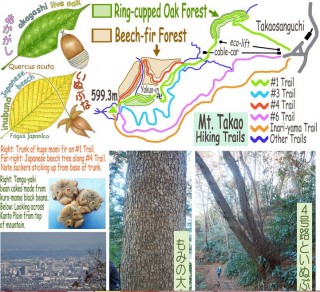▼ Mt. Takao Provides Opportunity To Study Wealth of Local Nature, Culture
- Category:Mountain
Last weekend I took my students on our annual field trip up Mt. Takao in western Tokyo. Only 600 meters high, this mountain is ideal for beginning hikers, but also provides abundant opportunities for studying local nature and culture. Our main goal was to identify and map some of the different kinds of forests found on Mt. Takao’s easiest hiking route, and the one always recommended for first-time visitors, the No. 1 Trail. This is also the most crowded trail, but passes right through a forest of ring-cupped oaks.
Ring-cupped oaks, generically called kashi in Japanese, are among the chief components of Asia’s evergreen broad-leaved forests, which extend across the subtropical and warm temperate zones from the Himalayas east to Japan. Close to 100 species have been identified, about 10 of which have reached Japan. The leaves of these species differ in size and shape, but all share a concentric pattern of scales on their cups.
The No. 1 Trail starts off as a rough-paved road that climbs steeply alongside a small creek. Near the head of the ravine the route suddenly switchbacks sharply to the right, running across the face of the mountain- side. The ring-cupped oak forest borders on the left here, just above the path.
After a short stretch, the main trail switchbacks sharply to the left, but a smaller side-path continues straight on, climbing steeply up to Konpiradai, a flat area offering a spectacular view eastwards across the Kanto Plain. From here the route climbs steeply along the ridge, hemmed in on both sides by big oaks and other evergreen broad-leaved trees. We were able to identify at least four species of ring-cupped oak.
Mt. Takao is a sacred mountain, and the No. 1 Trail is the historic Omotesando or main pilgrimage route. The trail passes right through the Yakuoin Buddhist temple, said to have been founded by the famous priest Gyoki in 744. The temple enshrines the healing Buddha Yakushinyorai and Izuna Gongen, a wild part-Shinto part-Buddhist deity that zips around the mountain slopes on the back of a sacred fox, and is served by Tengu helpers.
After resting at the top and stopping in the Visitor Center, we took the No. 4 trail on the way back. This trail runs along the north-facing slope of the ridge, which receives less sun than the southern slopes. As a result, the natural vegetation changes from warm-adapted ring-cupped oak forests to cold-adapted forests of inu-buna or Japanese beech (Fagus japonica) and momi fir.
At this time of year most of the deciduous trees were already bare of leaves, but we were easily able to identify the beeches by the numerous suckers growing out from the base of their greyish trunks. Some of the fir trees (Abies firma) in this forest have grown to fairly huge proportions.
- December 8, 2016
- Comment (0)
- Trackback(0)


